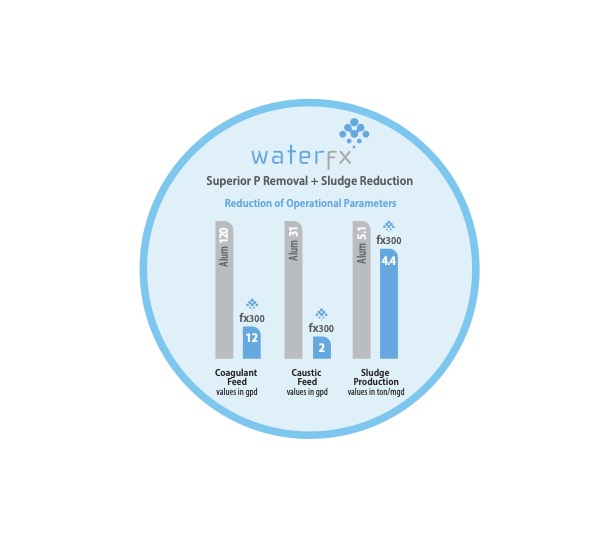To recap, JSSD, in Utah, was facing an extremely low total phosphorus limit of 0.06 mg/L for the 90-day average. Limits this low require chemical precipitation, and JSSD chose the traditional chemical coagulant of aluminum sulfate, alum. They spent over a year trying to stabilize their phosphorus removal process and achieve reliable compliance, with very limited success. At one point, they were adding over 140 gpd of alum to reduce the phosphorus concentration in their 375,000 gpd average daily flow. This high alum dose (which is highly acidic) greatly reduced the alkalinity in their process, requiring them to add caustic to raise the alkalinity required for nitrification and to adjust the pH of their effluent.
To see how switching to WaterFX helped JSSD achieve reliable compliance with their total phosphorus removal, while stabilizing their pH and alkalinity, almost totally eliminate their caustic feed, and reducing their chemical costs, see last month’s blog or the case study (Phosphorus Compliance with Bottomline Benefits Part 1 or Jordanelle Utah Case Study).
Chemical costs were not the only bottom-line benefit from switching to WaterFX.
Neo WaterFX’s unique chemistry with phosphorus also produces less chemical sludge, which saves money in sludge processing (polymer for dewatering, dewatering cycle time and operator attention) and in disposal costs.
Removing phosphorus with alum produces a large amount of chemical sludge, primarily due to the large dosages required to remove phosphorus to low levels. Removing phosphorus with WaterFX also produces chemical sludge. The first major difference is the dosage. Whereas the dosage of alum averaged between 100 and 120 gpd, the dosage of WaterFX required is only 12 gpd. That alone cut the amount of chemical sludge by about 90 percent.
The other main difference is the type of sludge created. Alum creates a fluffy floc that traps many other particles. This floc also traps a lot of water, binding it in the floc and often requiring additional polymer to break the floc and aid in dewatering. Even with additional polymer, the dewatered sludge often still contains a great deal of water, driving up disposal costs.
WaterFX creates crystals, not floc.
WaterFX’s bond with phosphorus is different. Rather than trapping phosphorus loosely in a floc, WaterFX binds tightly with phosphorus in a dense crystal. This crystalline precipitate does not bind water and so requires less polymer and dewaters more easily, producing a drier final sludge for disposal. Drier sludge means less water weight going to disposal and lower sludge disposal costs.
For JSSD, the average dewatered sludge with alum was 16.5% solids. With WaterFX, the solids increased to 17.5%. This means a net decrease of 6% total wet solids for the same dry weight of solids.
Net result for JSSD – significantly less sludge per million gallon.
For JSSD, this reduction in chemical sludge and increase in dry solids from dewatering reduced their total sludge requiring disposal from 5.1 tons per million gallons of treated wastewater to 4.4 tons per million gallons. This is a reduction of almost 14% in total sludge requiring disposal, or almost 100 tons per year at their current average daily flow of 375,000 gpd. As they grow into their total 1.2 MGD design capacity, these savings will continue to grow with them.
Compliance first – but cost savings are an added plus.
When it comes to choosing phosphorus removal methods, compliance has to be the number one consideration. BUT, when that compliance can be achieved more reliably, with less operator attention, fewer operational hiccups AND save money, that becomes a total win-win. That is the benefit you, like JSSD, may achieve by switching to Neo WaterFX. You will find all the details of JSSD’s pilot test experience in the Jordanelle Case Study.
The consultation is free and if WaterFX looks like a good fit for your wastewater system, our engineers can help you set up a pilot test to validate the savings – like JSSD did in 2021 and 2022. Contact us for that consult today.



